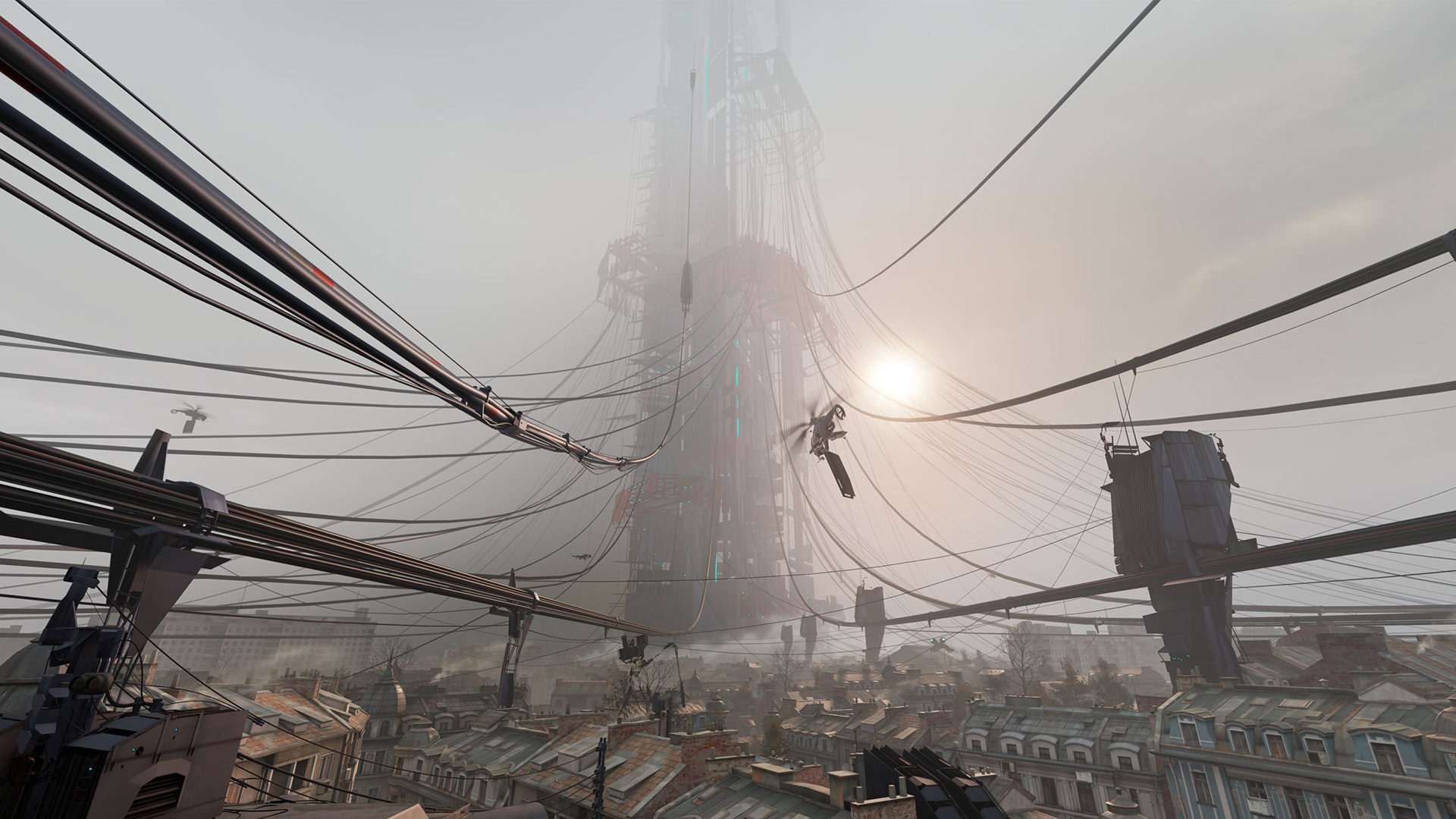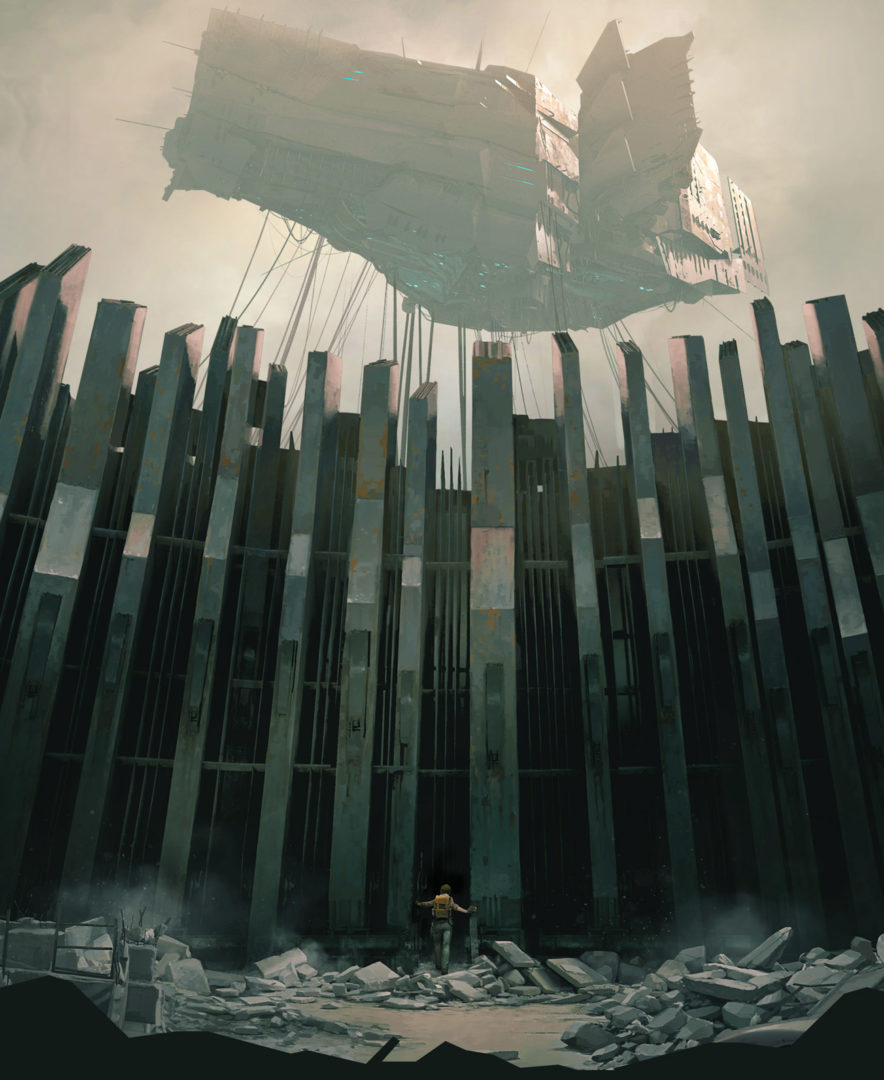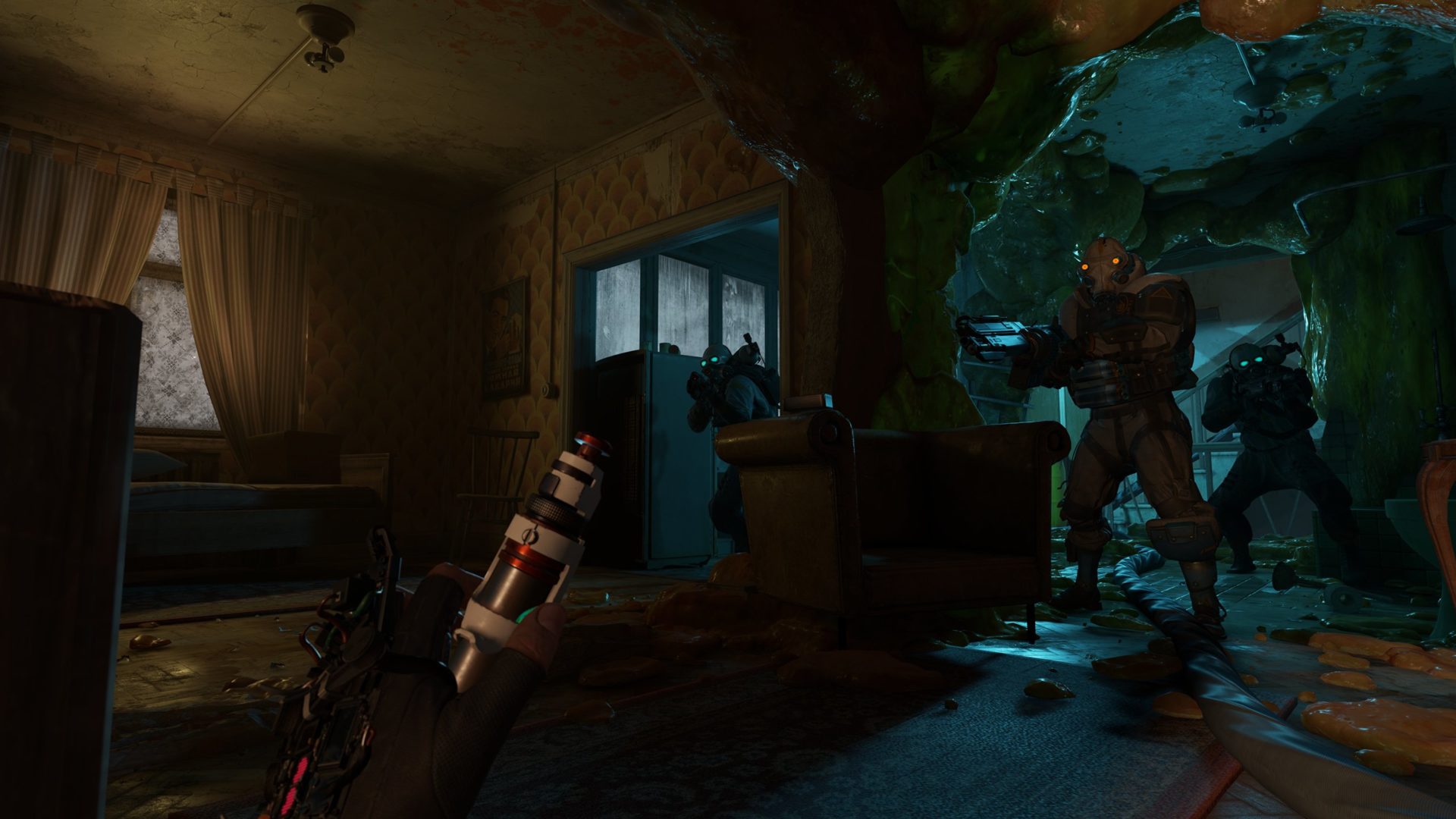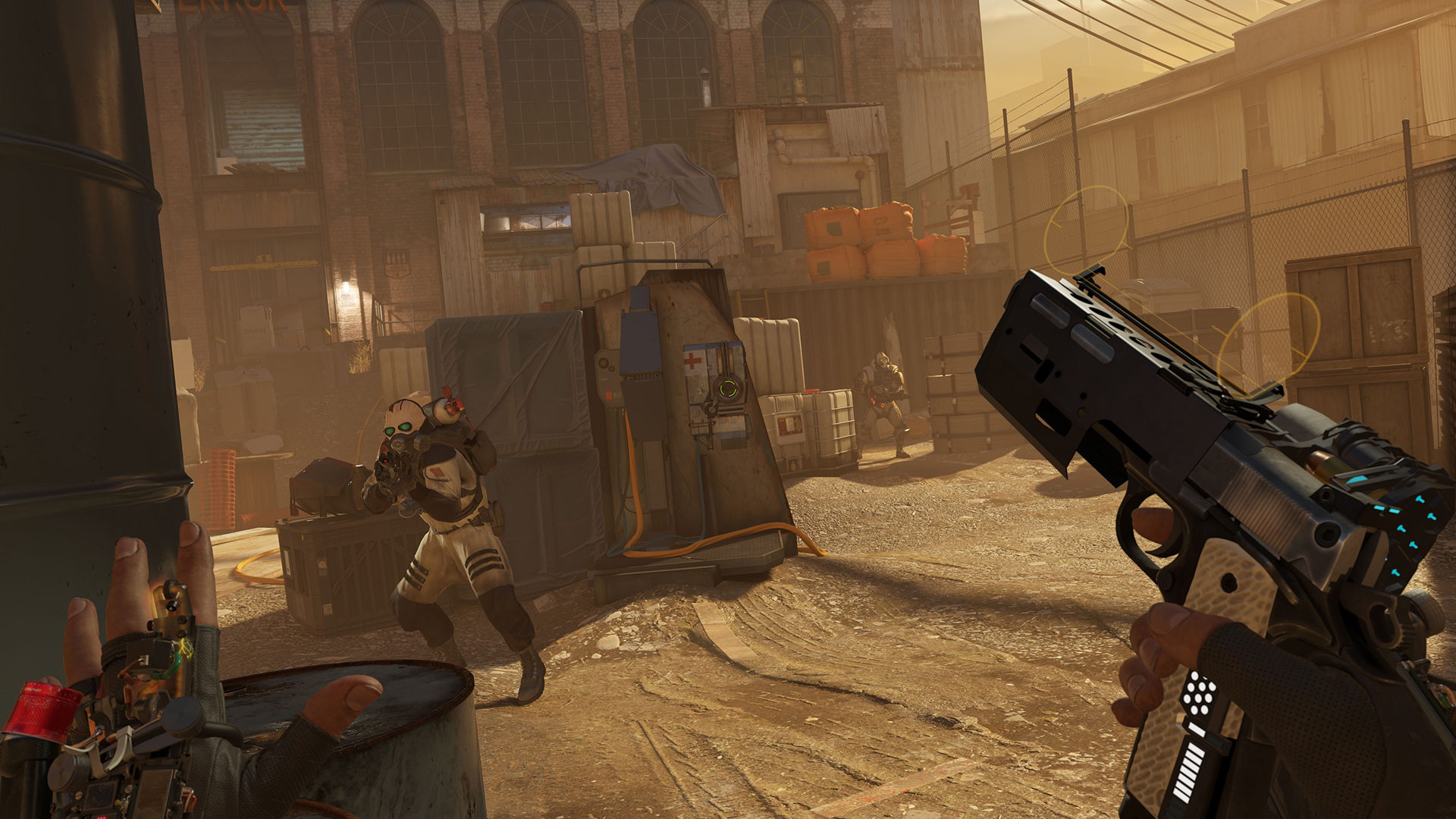When I took on this article, I wanted to avoid using Half-Life: Alyx as a vehicle to make a referendum on virtual reality gaming in general; after all, this is the first canon Half-Life in 13 years, and that’s enough to cover on its own, right? Well, yes and no. Valve’s efforts in reviving its signature franchise are tied to a bet it’s making on the future of gaming (and, incidentally, on the future of its own VR technology), and as such, the product itself can’t really be discussed without going into the ways that VR presents both a promising and disappointing path forward for triple-A titles. Half-Life: Alyx ends up being both a totally enjoyable and worthy successor to Half-Life 2: Episode 2 while also staying just this side of entirely inaccessible, and balancing the two aspects makes what is a genuinely fun romp much more complicated for its player.
So let’s get all the early VR hand-wringing from me out of the way: I’m super skeptical that this technology is really the wave of the future. Perhaps if you have a committed VR room with permanently installed sensors and a padded surface, along with an iron stomach and a healthy disposable income, you’ll disagree. And that’s fine! I think, as far as truly extravagant and frivolous pastimes go, VR is no worse and probably better than most. There is something intoxicating and transporting about putting on the goggles and suddenly being in City 17, which I’ve spent enough time in while playing Half-Life 2 to probably have equity on a nice little starter hovel.

It’s easy to imagine the implications spinning out from this feeling that have spawned so many of VR’s greatest hits so far—spending time in Gotham with Batman or on a Star Destroyer with Darth Vader—and could plausibly produce even more moving forward. To put on a lame teacher hat for a second, imagine being transported directly into Dostoyevsky’s Crime and Punishment or LeGuin’s The Dispossessed. It’s an incredibly powerful way to think about technology’s potential effects on our minds.
Sadly, though, the idea is mostly still hypothetical as far as I can tell. The physicality of the body itself makes physical movement in VR a tricky thing—for both the player and their avatar. Alyx circumvents a lot of this, and I have to give Valve credit for making the default mode of transportation a quick teleport triggered by the left joystick as opposed to the lurching nausea of real-time movement. Because while I would absolutely love to feel even more immersed in the game itself, I’m rocketed back to my physical roots when I take those steps and my brain punishes me for somehow moving-while-not-moving by making my stomach revolt.
And beyond the motion sickness issue, there’s just the… moving around while blindfolded issue. The action in Alyx is absolutely incredible, and the feeling of actually being in a firefight, ducking physically behind cover, peeking out to toss a grenade, and outwitting your enemies is incredibly satisfying—well, it’s completely satisfying until you slam your hand into a bookshelf or your sensor refuses to pick up your gun hand and you’re shot to death while trying to reload through a clipping graphics effect.

There’s nothing worse than feeling the full effect of Alyx’s immersion and then being brought out of it like that; it’s a truly new level of frustration. And this frustration is only a fraction of what it must feel like to play with disabilities—Alyx can be played sitting down, but it’s far less functional and enjoyable that way, and while the game does what it can for accessibility, the format is just a bit exclusive to the typically able-bodied. That’s not a critique specific to Alyx, and it isn’t even a critique of VR per se—it’s just the truth about a system that is probably not ready to become the universal standard for gaming experiences. And that’s even before the cost of a rig and a PC that can run it. It’s an exceptionally large pill to swallow to get to the game itself, and that’s a problem.
But after swallowing that pill, this game really does shine. The moment you begin, you’re given a skyline panorama of City 17 that transported me right back to the wonder and joy of playing Half-Life 2 in 2009 (I was late to the party). For all of its saturation in popular games media, Half-Life 2 was a magical experience, an absolute sea change of a game in look, atmosphere, and (thank you, Gravity Gun) mechanics. And one thing I have to give Valve and its commitment to making VR happen here is that the sensory experience of being back in that space is more evocative of a long-ago memory than anything I’ve previously experienced in gaming. You’re not just thinking about a game you loved; you’re there.
Ultimately, this is the most well-executed element of a very well-executed game. Valve is many things, not all good, but one thing the company is particularly skilled at is making a complete experience, and Alyx is no exception. What’s impressive here is that the narrative also takes this lead. There isn’t too much that’s changed in the name of “creating a new start,” nor is there too-rigid commitment to the older games. Alyx is its own thing, but it revels in reminding you of its predecessors. In this way it succeeds where franchises like Star Wars stumble: Alyx is committed to bringing you a new Half-Life story, with its own beats, but it is not interested in outstripping its signifiers and becoming something beyond. It knows what it does best and it tells the story it can. There’s not anything world-historically important about the premise—rescue your father, and then get roped into a heist job—but then again, who said the new Half-Life had to be important? It’s a fun story, artfully told through its writing and voice acting.

That goes for the visual element as well. The world itself tells a story very effectively, mostly thanks to the art direction in the game: the first scene allows you to doodle on the grimy windows of a City 17 safehouse while you listen to an expository cut-scene; the feeling of the grimy apartments gets under your (metaphorical) fingernails as you open and search through dusty detritus for bullets; and having to load a gun while a headcrab leaps at your actual face is exhilarating. To be even more specific (and while I don’t want to delve too far into spoilers) there’s a scene in the final act of the game that demonstrates the capacity of this visual element to a T. Alyx is in a dreamlike apartment building, with its ghostly tenant who cannot interact with her. Frozen in time, he (and I’ll just say here I think it’s pretty obviously young Eli Vance, Alyx’s dad) goes through the mundanity of his day, working hard and waiting by the mail for something more. Meanwhile the apartment itself shifts, as ground becomes ceiling, gravity tilts 90 degrees in each room, and you’re suddenly using chairs as platforming objects or grappling with a reflective parallax dividing the room horizontally. It is masterful work—the way that the building itself represents the fracture of Alyx’s mind and Eli’s stress is conveyed in a truly elegant way. If this was, as I suspect, one of the early prototypes for Alyx, then it’s no wonder they went whole hog in.
That said, this is not always the norm in the game. I hate to say it for a game with such potential in its final scenes, but Alyx often feels less like an elegant object and more like a layered spectacle, a sort of Universal Studios attraction that raises the stakes again and again in an effort to keep its riders entertained. As the game gets into its later stages, Alyx finds herself fighting Combine soldiers, and while this is fun initially as a new challenge, the wave after wave of firefights begin to feel perfunctory, like gates stopping you from getting to the more interesting parts of the game. Moreover, while the spectacle of, say, the abandoned zoo filled with antlions is beyond fun, I couldn’t shake the feeling that I was enjoying it in the same way as I would Back to the Future: The Ride. That’s not a critique necessarily! But for a game that will undoubtedly be hailed as a revolutionary shot across gaming’s bow, I’m not sure a theme park vibe is a good thing.

In the end, I think Alyx is kind of perfect for what it is: a blockbuster game that is smarter than most of its counterparts. Lest I be misunderstood: The game is a lot of fun and I endorse it as probably the best shooter I’ve played since 2016’s Doom. I just don’t think you should be buying a new PC and an Oculus, Vive, or Index quite yet.
More specifically, where I part ways with Alyx is in thinking about it as any kind of harbinger of future gaming. I’ve honestly gone back and forth on this for the last week, and I have come to the conclusion that, outside of some thrills and spills and environment exploration, this game didn’t have to be made in VR. Does the VR add something to the experience? Of course: Picking things up with the gravity gloves, tossing grenades, loading my pistol, and stashing ammo were all incredibly satisfying tactile experiences. But then again, you can get some fun experiences watching a film in IMAX or 3D, and we see very few IMAX- and 3D-exclusive films. I realize this is a bit apples to oranges, as Valve couldn’t exactly produce both a full-scope VR experience and a base game at the same time (or at least I don’t expect that it could have), and I know that there’s a lot of good things to say about pushing the envelope at the technological limit. But I know that this VR specificity is going to limit the audience for this game, and that sucks because it is smart and beautifully designed. I can’t entirely get past that as a critic or a gamer.
I think, finally, that Alyx is going to impact audiences in the same way and for the same reason Half-Life 2 did—how successful you think the game is is going to depend on how much it tugged at your emotions. Valve is very good at making games that play to its audience’s fear, sadness, and surprise, and Alyx is no different. But while there’s something certainly unique about embodying Alyx and being in City 17, I do think the emotional impact could have been made with the same force in a standard FPS. After all, we all remember that feeling of sudden freedom while defying physics with the Gravity Gun in Half-Life 2, right? Picking up massive former-obstacles and turning them into toys or weapons or both is fun in VR, but it’s fun on a screen too. Furthermore, I think the fact that many people are going to watch the dynamic and shocking ending of the game on YouTube instead of playing it themselves, and given how well-designed the entire final level is, that’s a real shame.
Hopefully, Valve uses this as an experiment or one-off and continues to include larger audiences, but I’m skeptical. If the Half-Life story has to continue in VR, I’ll probably continue to follow myself, but many, many others will not. And for a game that trades so heavily in the reputation of its predecessors, I have to think that’s a bit strange.
Header image credit: Valve

Trevor Strunk is a recovering English PhD, teacher, podcaster, and dad who lives somewhere around Philadelphia. He talks about videogames with various guests on No Cartridge, a podcast that can be found where all good podcasts are provided, and occasionally writes at no-cartridge.net. You can follow his more transient thoughts @hegelbon on twitter. Oh and go play Outer Wilds, his 2019 game of the year!